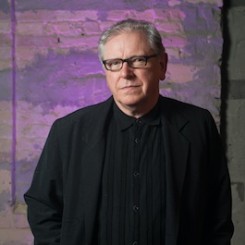randian: The biennale is titled “The Best of Times, The Worst of Times. Rebirth and Apocalypse in Contemporary Art.” What’s it about?
David Elliott: Well, it’s like all my large shows of contemporary art in that it gives a particular take on what is happening now and on why some of the best art being made is absolutely central to a wider appreciation and experience of the world. I am also making the point that the past can act as both a prison and a platform for change, especially when viewing the present and future….
randian: You’ve curated numerous major survey shows, including the last Sydney Biennale and “Bye Bye Kitty: Heaven and Hell in Contemporary Japanese Art,” on show last year at the Japan Society in New York. How is Kiev different?
DE: Until the early 1990s Kiev was part of the Soviet Union and its contemporary culture is still digesting this somewhat traumatic experience. I would not call these earlier exhibitions survey shows though; they were very much crafted for where they were shown. But this common particularity is meant to enhance rather than limit their relevance to other contexts because I stress connections in the ways that art can be looked at rather than a more hermetic approach.
randian: How did you develop the theme – is it related to Kiev and Ukraine in particular?
DE: The show is related to Kiev, the Ukraine and its history. The theme is truly “universal”!
randian: 100 artists will participate – how did you go about selecting them?
DE: I start with what I think is the big picture that is right for the Ukraine and then work inwards. Of course, I was not totally innocent of that region as I was one of the curators of “After the Wall: Art and Culture in post-Communist Europe,” which was shown in Stockholm, Budapest and Berlin in 1999-2000, but I needed to catch up over the past ten years.
randian: Thirteen artists are from China. That’s a lot. Was there a particular reason behind this or did it just happen?
DE: There is always a random element in such big shows simply because one cannot know everything — so the randomness is defined by one’s limitations! I’ve been working a lot in China recently so I’m up to speed there as well as in Japan, Central Asia and Mongolia. But as Ukraine and Kiev are straddling the western end of the Silk Road, it seemed to me to make sense to reactivate these links to get away from the old Soviet cul-de-sac of the “Friendship Countries” — and there are real cultural links here, much less random than going for broke, say, in Africa or Latin America. Lastly there is a shared history of aesthetic modernity between the Soviet Union and China in the form of Socialist Realism and its legacy which I start to unpack in some of the contemporary art.
Participating artists from China: Ai Weiwei, Wei Dong, Liu Jianhua, MadeIn Company, MAP Office, Shen Shaomin, Lam Tung Pang, Zhou Zixi, Song Dong, Wang Qingsong, Miao Xiaochun, Yin Xiuzhen, Yang Fudong
randian: In February and March, the President of the National University of Kyiv-Mohyla Academy, Serhiy Kvit, banned the Visual Culture Research Center’s exhibition “Ukrainian Body,” then the Centre, and finally the Centre’s building. That must have been quite some exhibition!
DE: The exhibition was okay — some works were good, others not so much, but the official response from the Academy President was so insulting and limiting to the right of free artistic expression that it felt like being back under Krushchev. I guess that this is one of the things I am referring to when I said that the past could be like a prison….
randian: Will the VCRC reopen?
DE: It looks like it will not at the Academy although I am sure that the VCRC can reopen somewhere else and will probably be better there.
randian: You’re also working on the Hong Kong Central Police Station project. How’s that coming along?
DE: Slowly. The building should be ready early 2015 but there is no clear view about how the project should be operated or funded. It’s not easy to set up a public contemporary arts hub from scratch with about 1,500 sq. m net of museum quality exhibition space. Some people seemed to be a bit worried that contemporary art could be a little controversial! They should look at the real world.
randian: When we visit Kiev, where should we go to eat and what should we order? (Are there any good Chinese restaurants in Kiev?)
DE: I haven’t looked for Chinese restaurants in Kiev. What kind of person do you think I am? Best snack is Salo — pork lard rubbed with salt and garlic and washed down by several hundred grams of honey pepper vodka — or Samogon, their word for hooch.
For the main meal, I recommend borsch(beetroot and meat soup). Deruny (potato pancakes) and golubtsy (cabbage leaves stuffed with meat, mushrooms and buckwheat) and then there’s lots of fresh grilled vegetables andshashlik (kebabed meats).
randian: And what do you recommend we take to read on the plane?
DE: The Collected Stories of Isaac Babel — particularly the Red Cavalry cycle. He was born in Odessa in 1894 and murdered by Stalin’s secret police in 1940. Another great Ukrainian writer is Mikhail Bulgakov. The Master and Margarita(1938) is one of the great metaphysical novels of the twentieth century, so good, in fact, that it was not published in Russia until about thirty years after it had been finished.

